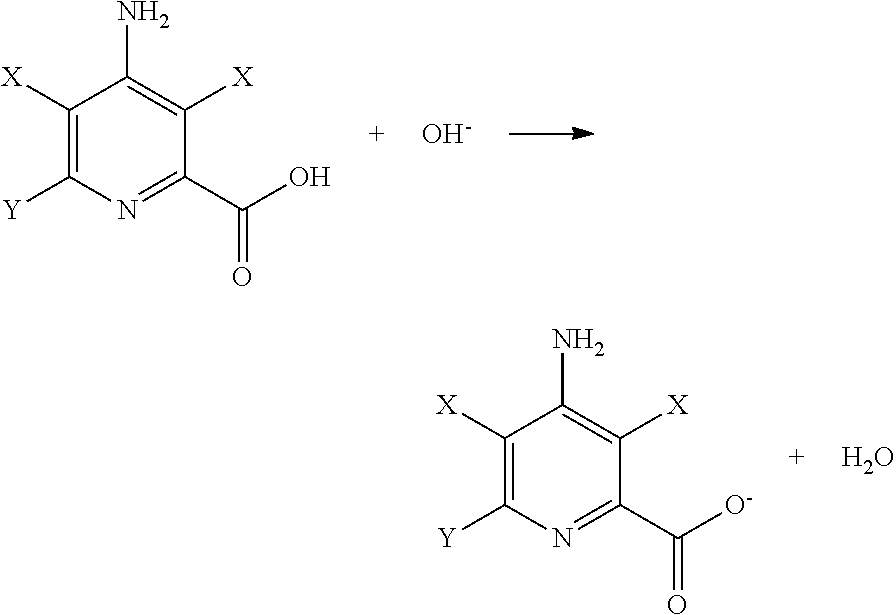Silver cathode activation
a silver cathode and activation technology, applied in the field of silver cathode activation, can solve the problem of slow reaction rate and achieve the effect of faster reaction ra
- Summary
- Abstract
- Description
- Claims
- Application Information
AI Technical Summary
Benefits of technology
Problems solved by technology
Method used
Image
Examples
examples
Preparation of 4-amino-3,5,6-trichloropyridine-2-carboxylic Acid (picloram) Feed Solution
[0035]To a 4-liter (L) flask was added 2420 grams (g) of hot water, 250 g of 50 percent by weight NaOH, 30 g of NaCl, and 300 g of picloram (95 percent). The solution was stirred for 30 minutes (min), filtered through a 1 micron polypropylene film., and transferred to a 5-L feed circulation tank. This solution weighed 3000 g and contained 9.5 weight percent 4-amino-3,5,6-trichloropyridine-2-carboxylic acid, 2.0 to 2.5 percent of excess NAM, and 1.0 percent of Nan. This feed solution was used in both the comparative example and the improved example for this disclosure.
example a
Preparation of 4-amino-36-dichloropyridine-2-carboxylic Acid With Anodization at 0.7 Volts (Comparative)
[0036]To an undivided electrochemical cell was added 500 g of the picloram feed solution. This feed solution was circulated at a rate of 4 Liters per minute (L / min) and a temperature of 43-45° C. through one undivided electrochemical cell. The size of the silver mesh electrode was 1.8 cm×15.4 cm. After normal anodization at +0.7 volts (V), the polarity of the cell was reversed and the electrolysis was started. The cathode working potential was controlled at −1.35 V relative to an Ag / AgCl (3.0 M Cl−) reference electrode. While recirculating the feed, a total of 10 mL of 50 percent by weight NaOH were added over the first 5 hours to maintain the NaOH concentration at 1.5-3.0 percent excess. The current started at 5.0 amps and slowly decreased to 0.6 amp at 24 hours.
[0037]No more anodization was needed after the electrolysis was started. At 8 hours, the cell effluent has 68% aminopyr...
example 1
Preparation of 4-amino-3,6-dichloropyridine-2-carboxylic Acid With Anodization at ±1.2 Volts
[0038]To the same undivided electrochemical cell in Example A was added 500 g of the picloram feed solution. This feed solution was circulated at a rate of 4 L / min and a temperature of 43-45° C. through one undivided electrochemical cell. After normal. anodization at +1.2 volts (V), the polarity of the cell was reversed and the electrolysis was started, The cathode working potential was controlled at −1.35 V relative to an Ag / AgCl (3.0 M Cl−) reference electrode. While recirculating the feed, a total of 10 mL of 50 percent by weight NaOH were added over the first 5 hours to maintain the NaOH concentration at 1.5-3.0 percent excess. The current started at 6.5 amps and slowly decreased to 0.7 V at 2.4 hours.
[0039]No more anodization was needed after the electrolysis was started. At 8 hours, the cell effluent had 76% aminopyralid and 17% picloram (both in HPLC area %), At 24 hours, the cell effl...
PUM
| Property | Measurement | Unit |
|---|---|---|
| reduction potential | aaaaa | aaaaa |
| weight percent | aaaaa | aaaaa |
| temperature | aaaaa | aaaaa |
Abstract
Description
Claims
Application Information
 Login to View More
Login to View More - R&D
- Intellectual Property
- Life Sciences
- Materials
- Tech Scout
- Unparalleled Data Quality
- Higher Quality Content
- 60% Fewer Hallucinations
Browse by: Latest US Patents, China's latest patents, Technical Efficacy Thesaurus, Application Domain, Technology Topic, Popular Technical Reports.
© 2025 PatSnap. All rights reserved.Legal|Privacy policy|Modern Slavery Act Transparency Statement|Sitemap|About US| Contact US: help@patsnap.com



